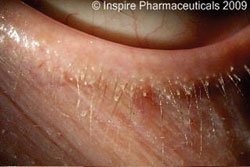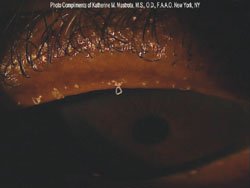Blepharitis: the importance of proper diagnostics and treatment
Specialist details how to recognize and combat this common condition.
 Marguerite B. McDonald |
Blepharitis is a common condition that presents ophthalmologists with several challenges. Despite the frequency with which patients report symptoms of this condition, it remains largely underdiagnosed or misdiagnosed. This can be attributed in large part to the lack of epidemiologic data on its prevalence and management.
What is certain are the negative effects that blepharitis has on the quality of our patients’ lives. Characterized by red, bleary, crusted, scaly and puffy eyes that itch and burn, blepharitis can affect visual function and physical appearance, making patients feel uncomfortable and unattractive. I have also had some patients complain that they felt their eyes gave others the impression of an underlying emotional, alcohol or drug problem, which has had a negative effect on their social and professional interactions.
From a clinical standpoint, blepharitis can affect the surgeon’s treatment plan and compound co-existing conditions. Blepharitis is a known cause of evaporative dry eye, chalazia formation, loss of cilia, and even corneal neovascularization and ulceration. Ultimately, if left untreated, it can cause potentially serious surgical complications, including slow visual recovery, decreased and/or fluctuating vision, and endophthalmitis (in the case of intraocular surgery, such as phaco and penetrating keratoplasty). This makes proper diagnosis and subsequent treatment imperative for all eye care practitioners.
Diagnosing blepharitis
Diagnosing blepharitis is more likely if one makes a conscious effort to look for it. However, many of us give only a quick glance at the lids during a surgical assessment, concentrating more fully upon the intraocular pathology that is present. Nevertheless, the prevalence of this condition cannot be ignored: In a recent U.S. survey, 34 million adults experienced at least one of three symptoms most commonly associated with blepharitis at least half of the time in the past year. Additionally, of these survey respondents, only 4.5 million confirmed that they had received treatment for their blepharitis. This demonstrates a large gap of 29.5 million patients between those treated and those experiencing symptoms associated with blepharitis.
I have found that a few simple questions can help attune me and my staff in identifying blepharitis and differentiating it from common symptoms often presented in dry eye syndrome. Because blepharitis and dry eye syndrome present with unique diurnal patterns, asking patients at what time of day their symptoms peak can clarify the diagnosis.
In blepharitis, prolonged exposure to inflammatory mediators in the tear film during sleep can cause ocular irritation upon waking. As such, blepharitis patients tend to be most symptomatic early in the morning. For dry eye disease patients, discomfort worsens as the eye is exposed to the environment throughout the day, so their symptoms typically peak in the late afternoon or evening.
 Figure 1: Anterior blepharitis with scurf and loss of cilia. Image: Inspire
Pharmaceuticals |
It is important to also note a difference in diagnosing both the anterior and posterior forms of blepharitis. Anterior blepharitis is often caused by Staphylococcus aureus, Staphylococcus epidermidis and Corynebacterium spp. and is characterized by excessive colonization of the lid margin. Signs include collarettes at the base of eyelashes as well as red, itchy and swollen eyelids (Figure 1).
 Figure 2: Posterior blepharitis, or meibomian gland disease, shows inspissation of the meibomian glands and the creamy, toothpaste-like meibum that is characteristic of meibomian gland disease (it is supposed to be clear and liquidy). Image: Mastrola KM |
Posterior blepharitis is often termed meibomian gland disease. While patients present with similar signs and symptoms as anterior, they also often demonstrate other signs including inspissations of the meibomian glands, telangiectasia and thickened eyelid margins (Figure 2).
Treatment options
Traditional treatment of blepharitis, including lid hygiene and warm compresses, followed by gentle lid cleaning and mechanical lid massage, often provides some improvement in symptoms. The ideal therapy, however, is employing these measures along with a topical antibiotic to address both the infectious and inflammatory aspects of the disease.
Fluoroquinolones are rapidly cleared from the ocular surface, limiting the sustained therapeutic effect. As such, they are not an ideal option for long-term management of blepharitis.
Chronic blepharitis can take weeks or months to manage. Thus, any therapy employed to treat it must maintain therapeutic concentrations in the target tissues without continuous dosing.
AzaSite (topical azithromycin ophthalmic solution 1%, Inspire Pharmaceuticals) is a newer broad-spectrum antimicrobial with long-lasting concentrations and significant anti-inflammatory effects. Currently indicated for the treatment of bacterial conjunctivitis, azithromycin has amassed additional clinical trial data that suggests it may be an effective treatment for both anterior and posterior blepharitis. Three post-marketing studies have been completed showing azithromycin reduces signs and symptoms of blepharitis. One study showed improvement after 2 weeks of treatment significantly greater than warm compresses alone. Another showed significant improvement in signs and symptoms after 4 weeks of treatment that continued another 4 weeks after discontinuation of the drug.
In addition, azithromycin exhibits significant anti-inflammatory activity. According to one study, azithromycin treatment reduced overexpression of matrix metalloproteinase-9, a key mediator in inflammation, by 33%. Given that inflammation plays a key role in blepharitis, particularly posterior blepharitis, this anti-inflammatory activity could have useful therapeutic effects.
Conclusion
Often neglected by patients and physicians alike, blepharitis is a common condition that negatively affects comfort, appearance, visual function and surgical recovery. Treating this condition improves patient quality of life and comfort and can enhance postoperative recovery and visual acuity. Better diagnosis and newer antibiotic options are expanding our ability to identify and treat this chronic condition.
References:
- Haque R, et al. Multi-center, open-label study evaluating the efficacy of azithromycin ophthalmic solution 1% on the signs and symptoms of subjects with blepharitis. Cornea. 2009. In press.
- Jacot JL, et al. Evaluation of MMP2/9 modulation by azithromycin and Durasite on human corneal epithelial cells and bovine corneal endothelial cells in vitro. Abstract presented at: Association for Research in Vision and Ophthalmology 2008 Annual Meeting; April 27-May 1, 2008; Fort Lauderdale, FL.
- John T, Shah AA. Use of azithromycin ophthalmic solution in the treatment of chronic mixed anterior blepharitis. Ann Ophthalmol (Skokie). 2008;40(2):68-74.
- Lemp MA, Nichols KK. Blepharitis in the United States 2009: a survey-based perspective on prevalence and treatment. Ocul Surf. 2009; 7(2 Suppl):S1-S14.
- Luchs J. Efficacy of topical azithromycin ophthalmic solution 1% in the treatment of posterior blepharitis. Adv Ther. 2008;25(9):858-870.
- Torkildsen G, O’Brien TP. Conjunctival tissue pharmacokinetic properties of topical azithromycin 1% and moxifloxacin 0.5% ophthalmic solutions: a single-dose, randomized, open-label, active-controlled trial in healthy adult volunteers. Clin Ther. 2008;30(11):2005-2014.
- Marguerite B. McDonald, MD, can be reached at OCLI, 360 Merrick Road, Lynbrook, NY 11563, U.S.A.; +1-516-593-7709; fax: +1-504-232-3641; e-mail: margueritemcdmd@aol.com. Dr. McDonald is a consultant for Inspire.

